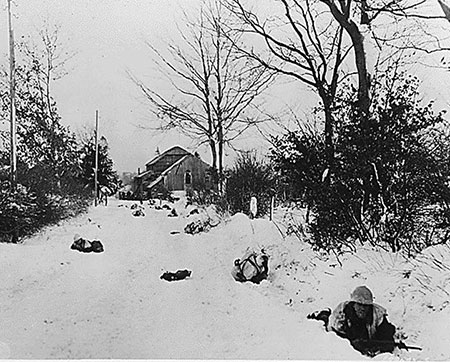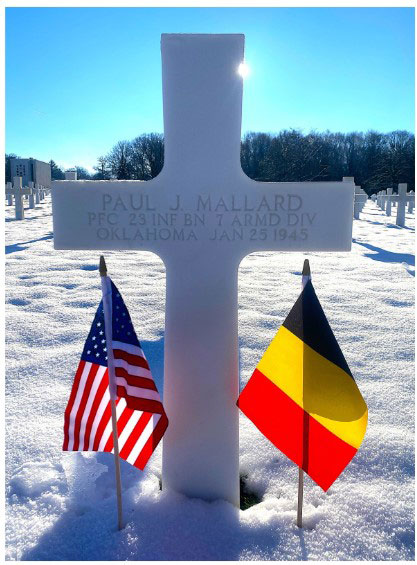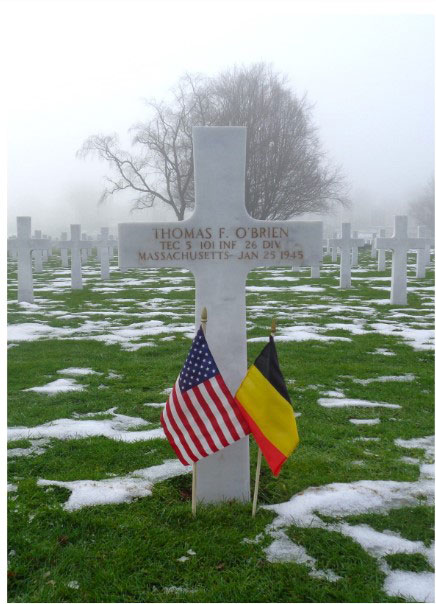January 24th, 2025
The Battle of the Bulge, Dec. 16, 1944, to Jan. 25, 1945, stands as one of the most significant military engagements of World War II, marking the final large-scale offensive by Nazi Germany on the Western Front. Located in the dense Ardennes Forest, the battle saw fierce combat as German forces attempted to break through the Allied lines and recapture vital territory. Despite initial successes by the Germans, the eventual victory by U.S. and Allied forces marked a crucial turning point in the war, signifying not just military triumph, but also progress toward final victory in Europe.
 The Germans launched their surprise offensive to divide the American and British forces and capture the important port of Antwerp. Their initial breakthrough caused a “bulge” in the Allied lines, forcing American forces to respond quickly under challenging conditions. The 99th, 106th, 28th, and 2nd Infantry Divisions as well as elements of the 7th and 9th Armored Divisions bore the brunt of the initial onslaught while other divisions, including the 101st and 82nd Airborne Divisions were rushed in as reinforcements, notably during the siege of Bastogne. In that critical crossroads city, U.S. forces, despite being surrounded, held out against repeated German attacks and delayed the German advance. Gen. Anthony McAuliffe’s legendary defiance to the German demand for surrender, with his famous “Nuts!” reply, became a symbol of American determination.
The Germans launched their surprise offensive to divide the American and British forces and capture the important port of Antwerp. Their initial breakthrough caused a “bulge” in the Allied lines, forcing American forces to respond quickly under challenging conditions. The 99th, 106th, 28th, and 2nd Infantry Divisions as well as elements of the 7th and 9th Armored Divisions bore the brunt of the initial onslaught while other divisions, including the 101st and 82nd Airborne Divisions were rushed in as reinforcements, notably during the siege of Bastogne. In that critical crossroads city, U.S. forces, despite being surrounded, held out against repeated German attacks and delayed the German advance. Gen. Anthony McAuliffe’s legendary defiance to the German demand for surrender, with his famous “Nuts!” reply, became a symbol of American determination.
By mid-January 1945, the Allies had regained the initiative. The American 3rd Army, led by Gen. George S. Patton, advanced to relieve Bastogne, while improved weather conditions allowed for the resumption of Allied air attacks, which inflicted heavy losses on the Germans. The American 1st Army, supported by the British 30th Corps, simultaneously counterattacked the northern shoulder of the bulge. Despite the brutal winter conditions and heavy casualties—around 75,000 U.S. service members were killed, wounded or captured—the German forces suffered far worse losses, with around 100,000 casualties. This marked the failure of the German offensive and the beginning of the Allies’ final push into Germany.
The end of the Battle of the Bulge, Jan. 25, 1945, was a decisive moment for the U.S. military and its Allies. For the U.S., the battle showcased their resilience in the face of surprise and adversity. The successful defense of key positions, the eventual counteroffensive, and the clearing of the “bulge” in the lines gave the Allies a critical victory at a time when Germany’s strategic options were rapidly diminishing. The heavy losses sustained by Germany, both in terms of manpower and equipment, significantly weakened their ability to mount future offensives.
This victory also served as a powerful symbol of progress for the U.S. and Allied forces. By stopping the German advance and pushing them back, the Allies regained momentum on the Western Front, preparing for the eventual final assault on Nazi Germany. The Battle of the Bulge marked the last significant German effort to change the course of the war on the Western Front, and with its failure, the Allies solidified their path to victory. It showed the ability of American forces to withstand and ultimately overcome the surprise German offensive highlighting their military effectiveness. This battle, and its conclusion, played a pivotal role in the final stages of World War II, as the Allies continued their march toward Germany and the defeat of Nazi forces.
The significance of this battle is commemorated in various American Battle Monuments Commission sites, including Ardennes American Cemetery and Henri-Chapelle American Cemetery in Belgium as well as Luxembourg American Cemetery in Luxembourg. Those cemeteries stand as solemn reminders of the sacrifices made by American service members during this battle and the critical role they played in the eventual liberation of Europe.
The American Battle Monuments Commission commemorates, among others, service members who perished during this offensive including Pfc. Paul Jack Mallard, Tec5 Thomas Francis “Red” O’Brien, and Pfc. Domenic Scannapieco.
Mallard was born April 15, 1919, in Blackwell, Oklahoma. He had three siblings and completed three years of high school. In 1939, Paul married Letha Elaine Tucker, and by 1940, he worked as an interior decorator and paperhanger. In 1940, he registered for the draft and was inducted into the U.S. Army in February 1944, assigned to Company C, 23rd Armored Infantry Battalion, 7th Armored Division
. Mallard’s unit fought across France as part of Patton’s 3rd Army, seeing their first combat at Chartres. They helped liberate several towns, including Reims, Chateau-Thierry and Verdun. By September 1944, they were involved in heavy fighting in Metz, and later participated in Operation Market Garden, protecting airborne divisions. As the Battle of the Bulge began in December 1944, Mallard’s division was sent to St. Vith to halt the German advance, where they saw intense combat and allowed reinforcements to reach Bastogne.
On Jan. 23, 1945, Mallard’s company helped recapture St. Vith. On the final day of the Battle of the Bulge, Jan. 25, 1945, his unit attacked the Belgian town of Wallerode, facing heavy artillery and small arms fire. During house-to-house fighting, Mallard was killed by a German sniper, according to a fellow soldier. Initially reported as missing in action, his remains were later identified. At the time of his death, Mallard was 25 years old, leaving behind a wife and daughter. His bravery during the Battle of the Bulge remains a testament to his sacrifice for freedom.
Mallard was posthumously awarded the Bronze Star and Purple Heart. He is buried in Plot C, Row 12, Grave 40 at Ardennes American Cemetery.

Born June 10, 1921, in Providence, Rhode Island, O’Brien grew up in Massachusetts. In 1942, he volunteered for service and joined the 101st Infantry Regiment of the 26th Infantry Division.
During the Battle of the Bulge in the winter of 1944, O’Brien’s unit fought in harsh conditions, facing snow and bitter cold. As part of Patton’s Third Army, the 101st Infantry helped relieve the besieged 101st Airborne Division at Bastogne, engaging in fierce combat to break the German encirclement.
In January 1945, O’Brien’s unit fought against the German 5th Fallschirmjäger Division. On Jan. 25, 1945, O’Brien was killed by a German sniper’s bullet in the neck while guarding a crossroads outside Clervaux, Luxembourg. He was 24 years old.
O’Brien’s sacrifice serves as a reminder of the hardships and heroism of those who fought in the Battle of the Bulge. His division, the 26th Infantry, has a long history dating back to the Civil War and continues today as the 26th Maneuver Enhancement Brigade in the Massachusetts Army National Guard. He is forever remembered at Henri-Chapelle American Cemetery in Plot F, Row 13, Grave 4.

Scannapieco, a member of the U.S. Army, was serving in northern Luxembourg during the final days of the Battle of the Bulge in January 1945. On a cold January day, 80 years ago, Scannapieco and a friend were taking a break while digging ditches near Heinerschied. The two infantrymen, who had become close friends during their service, paused to chat and smoke when a lieutenant noticed them and ordered them to get back to work.
As the two soldiers resumed their duties, they walked around different sides of their ditch. Scannapieco’s friend later recalled seeing a mortar shell explode near them, but he did not see Scannapieco again. Tragically, Scannapieco was killed in the explosion, leaving behind a memory of his last moments with his friend.
For years, the American Battle Monuments Commission has placed flowers on Scannapieco’s grave at the Luxembourg American Cemetery, located in Plot G, Row 7, Grave 1. The bouquets, placed every year on January 25, were sent by his friend, who had been with him when he died. Despite the brief six-month friendship they shared, the bond between the two soldiers remained strong, and the friend’s dedication to honoring Scannapieco’s memory has been unwavering.
Scannapieco’s sacrifice, remembered each year by his friend, symbolizes the deep connections formed in the hardships of war. His grave at the Luxembourg American Cemetery stands as a testament to the bravery and loss experienced during the Battle of the Bulge, a battle that marked the beginning of the end of Nazi Germany’s hold on Europe.

For more than 100 years, the American Battle Monuments Commission has been committed to its mission: honoring the service, achievements and sacrifices of the U.S. service members who made the ultimate sacrifice during American conflicts abroad, including World War II. back...
 The Germans launched their surprise offensive to divide the American and British forces and capture the important port of Antwerp. Their initial breakthrough caused a “bulge” in the Allied lines, forcing American forces to respond quickly under challenging conditions. The 99th, 106th, 28th, and 2nd Infantry Divisions as well as elements of the 7th and 9th Armored Divisions bore the brunt of the initial onslaught while other divisions, including the 101st and 82nd Airborne Divisions were rushed in as reinforcements, notably during the siege of Bastogne. In that critical crossroads city, U.S. forces, despite being surrounded, held out against repeated German attacks and delayed the German advance. Gen. Anthony McAuliffe’s legendary defiance to the German demand for surrender, with his famous “Nuts!” reply, became a symbol of American determination.
The Germans launched their surprise offensive to divide the American and British forces and capture the important port of Antwerp. Their initial breakthrough caused a “bulge” in the Allied lines, forcing American forces to respond quickly under challenging conditions. The 99th, 106th, 28th, and 2nd Infantry Divisions as well as elements of the 7th and 9th Armored Divisions bore the brunt of the initial onslaught while other divisions, including the 101st and 82nd Airborne Divisions were rushed in as reinforcements, notably during the siege of Bastogne. In that critical crossroads city, U.S. forces, despite being surrounded, held out against repeated German attacks and delayed the German advance. Gen. Anthony McAuliffe’s legendary defiance to the German demand for surrender, with his famous “Nuts!” reply, became a symbol of American determination.By mid-January 1945, the Allies had regained the initiative. The American 3rd Army, led by Gen. George S. Patton, advanced to relieve Bastogne, while improved weather conditions allowed for the resumption of Allied air attacks, which inflicted heavy losses on the Germans. The American 1st Army, supported by the British 30th Corps, simultaneously counterattacked the northern shoulder of the bulge. Despite the brutal winter conditions and heavy casualties—around 75,000 U.S. service members were killed, wounded or captured—the German forces suffered far worse losses, with around 100,000 casualties. This marked the failure of the German offensive and the beginning of the Allies’ final push into Germany.
The end of the Battle of the Bulge, Jan. 25, 1945, was a decisive moment for the U.S. military and its Allies. For the U.S., the battle showcased their resilience in the face of surprise and adversity. The successful defense of key positions, the eventual counteroffensive, and the clearing of the “bulge” in the lines gave the Allies a critical victory at a time when Germany’s strategic options were rapidly diminishing. The heavy losses sustained by Germany, both in terms of manpower and equipment, significantly weakened their ability to mount future offensives.
This victory also served as a powerful symbol of progress for the U.S. and Allied forces. By stopping the German advance and pushing them back, the Allies regained momentum on the Western Front, preparing for the eventual final assault on Nazi Germany. The Battle of the Bulge marked the last significant German effort to change the course of the war on the Western Front, and with its failure, the Allies solidified their path to victory. It showed the ability of American forces to withstand and ultimately overcome the surprise German offensive highlighting their military effectiveness. This battle, and its conclusion, played a pivotal role in the final stages of World War II, as the Allies continued their march toward Germany and the defeat of Nazi forces.
The significance of this battle is commemorated in various American Battle Monuments Commission sites, including Ardennes American Cemetery and Henri-Chapelle American Cemetery in Belgium as well as Luxembourg American Cemetery in Luxembourg. Those cemeteries stand as solemn reminders of the sacrifices made by American service members during this battle and the critical role they played in the eventual liberation of Europe.
The American Battle Monuments Commission commemorates, among others, service members who perished during this offensive including Pfc. Paul Jack Mallard, Tec5 Thomas Francis “Red” O’Brien, and Pfc. Domenic Scannapieco.
Mallard was born April 15, 1919, in Blackwell, Oklahoma. He had three siblings and completed three years of high school. In 1939, Paul married Letha Elaine Tucker, and by 1940, he worked as an interior decorator and paperhanger. In 1940, he registered for the draft and was inducted into the U.S. Army in February 1944, assigned to Company C, 23rd Armored Infantry Battalion, 7th Armored Division
. Mallard’s unit fought across France as part of Patton’s 3rd Army, seeing their first combat at Chartres. They helped liberate several towns, including Reims, Chateau-Thierry and Verdun. By September 1944, they were involved in heavy fighting in Metz, and later participated in Operation Market Garden, protecting airborne divisions. As the Battle of the Bulge began in December 1944, Mallard’s division was sent to St. Vith to halt the German advance, where they saw intense combat and allowed reinforcements to reach Bastogne.
On Jan. 23, 1945, Mallard’s company helped recapture St. Vith. On the final day of the Battle of the Bulge, Jan. 25, 1945, his unit attacked the Belgian town of Wallerode, facing heavy artillery and small arms fire. During house-to-house fighting, Mallard was killed by a German sniper, according to a fellow soldier. Initially reported as missing in action, his remains were later identified. At the time of his death, Mallard was 25 years old, leaving behind a wife and daughter. His bravery during the Battle of the Bulge remains a testament to his sacrifice for freedom.
Mallard was posthumously awarded the Bronze Star and Purple Heart. He is buried in Plot C, Row 12, Grave 40 at Ardennes American Cemetery.

Born June 10, 1921, in Providence, Rhode Island, O’Brien grew up in Massachusetts. In 1942, he volunteered for service and joined the 101st Infantry Regiment of the 26th Infantry Division.
During the Battle of the Bulge in the winter of 1944, O’Brien’s unit fought in harsh conditions, facing snow and bitter cold. As part of Patton’s Third Army, the 101st Infantry helped relieve the besieged 101st Airborne Division at Bastogne, engaging in fierce combat to break the German encirclement.
In January 1945, O’Brien’s unit fought against the German 5th Fallschirmjäger Division. On Jan. 25, 1945, O’Brien was killed by a German sniper’s bullet in the neck while guarding a crossroads outside Clervaux, Luxembourg. He was 24 years old.
O’Brien’s sacrifice serves as a reminder of the hardships and heroism of those who fought in the Battle of the Bulge. His division, the 26th Infantry, has a long history dating back to the Civil War and continues today as the 26th Maneuver Enhancement Brigade in the Massachusetts Army National Guard. He is forever remembered at Henri-Chapelle American Cemetery in Plot F, Row 13, Grave 4.

Scannapieco, a member of the U.S. Army, was serving in northern Luxembourg during the final days of the Battle of the Bulge in January 1945. On a cold January day, 80 years ago, Scannapieco and a friend were taking a break while digging ditches near Heinerschied. The two infantrymen, who had become close friends during their service, paused to chat and smoke when a lieutenant noticed them and ordered them to get back to work.
As the two soldiers resumed their duties, they walked around different sides of their ditch. Scannapieco’s friend later recalled seeing a mortar shell explode near them, but he did not see Scannapieco again. Tragically, Scannapieco was killed in the explosion, leaving behind a memory of his last moments with his friend.
For years, the American Battle Monuments Commission has placed flowers on Scannapieco’s grave at the Luxembourg American Cemetery, located in Plot G, Row 7, Grave 1. The bouquets, placed every year on January 25, were sent by his friend, who had been with him when he died. Despite the brief six-month friendship they shared, the bond between the two soldiers remained strong, and the friend’s dedication to honoring Scannapieco’s memory has been unwavering.
Scannapieco’s sacrifice, remembered each year by his friend, symbolizes the deep connections formed in the hardships of war. His grave at the Luxembourg American Cemetery stands as a testament to the bravery and loss experienced during the Battle of the Bulge, a battle that marked the beginning of the end of Nazi Germany’s hold on Europe.

For more than 100 years, the American Battle Monuments Commission has been committed to its mission: honoring the service, achievements and sacrifices of the U.S. service members who made the ultimate sacrifice during American conflicts abroad, including World War II. back...

